Lightening the shade of a person's teeth is known as teeth whitening, teeth bleaching, laser teeth whitening, zoom whitening, or power whitening. Bleaching is the word used to describe the chemical breakdown of the chromogens inside or on the tooth. When teeth get discoloured over time for various causes, regular brushing is not enough to remove stubborn stains from smoking, coffee, tea, and certain foods altogether. Whitening is frequently desired and might be obtained by altering the tooth enamel's hue.
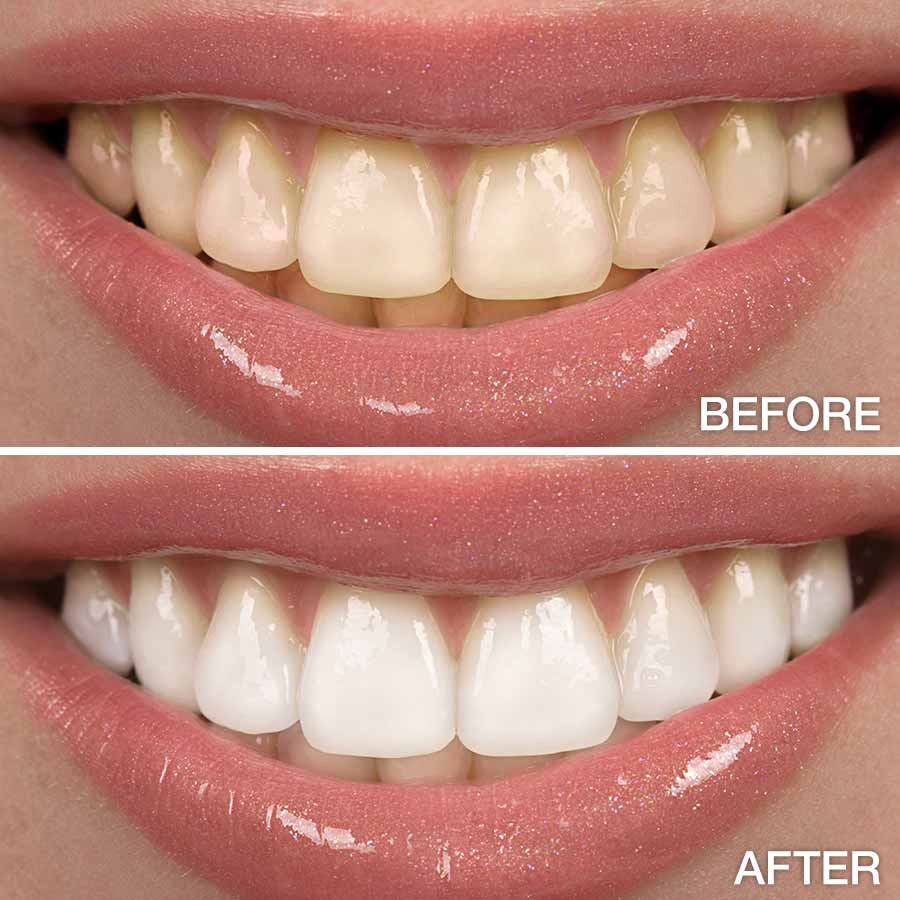
Tooth Whitening has become an accessible and easy way to improve appearance and instantly create a positive first impression. It is one of the cosmetic dental treatments that can dramatically beautify the natural smile of nearly every patient and produce those results in minutes. It can lighten teeth three to eight shades within a single hour. It's also the most economical, budget-friendly, and cheap cosmetic dental procedure.
We Can Help With Professional Teeth Whitening. Fortunately, that help is available at the dental office, and it is a safe, effective way to brighten your smile. Teeth tend to get darker as we age. This results in a noticeably reduced amount of lightness and an increase in yellowness, which can be attributed to secondary dentin formation and enamel thinning due to tooth wear. Gender or race has little impact on tooth colour.
There are many reasons why people choose to whiten their teeth, but some people may also have a recommendation from a dentist.
It is recommended that the patient visit the dentist for a thorough oral checkup (looking at their hard and soft tissues, their restorations' placement and condition, and occasionally taking x-rays to assess the type and extent of any potential irregularities), which also includes a complete medical, dental, and social history (including any allergies or sensitivities), before moving on to teeth whitening options. This will enable the dentist to determine whether the patient will be a suitable candidate for the teeth whitening procedure and determine whether any other therapy, like teeth scaling and polishing, dental veneers, dental crowns, or if the patient needs tooth fillings to eliminate cavities before or after the teeth whitening procedure. Excessive sensitivity and other issues might arise if this is done after the whitening solutions are applied to the tooth surface.
The dentist would next use an ultrasonic scaler, manual tools to remove calculus, and prophy pastes to remove the extrinsic stains listed above from the tooth surface if needed. This will provide a clean surface for whichever tooth-whitening process the patient uses best.
The next step is to guide you on which teeth whitening method will suit you according to your teeth' situation and budget. After agreeing on teeth whitening charges and in-office treatment options, the dentist will perform teeth whitening on the same day or delay the process for 2 to 5 days after scaling and polishing unless the gums heal if they are bleeding or swollen.
This is the most commonly practised way in dental clinics. Professional teeth whitening uses high-concentration bleaching gels containing 40 per cent hydrogen peroxide to wash off the yellow colour of the teeth quickly. They are unavailable over the counter because of the technique-sensitive procedure only a dentist can do.
A thin plastic device known as a retractor will hold your lips and cheeks away from your teeth. The dentist will take pictures of your teeth and save them before treatment to show you the after-teeth whitening results, and the tooth color is measured using the whitening shade charts. The efficiency of the whitening process is determined by these hues, which can range from two to seven shades. Your gums and tooth-root surfaces will be covered with a protective barrier to ensure the safety of the gums and mucosa as a professional-strength hydrogen peroxide gel is applied. Only dentists are permitted to administer bleaching chemicals.
The gel will be left on for 3 to 20 minutes or as the teeth whitening Gel Company recommends. When removed, the results will be noticeable immediately, and you will see your sparkling, dazzling smile, which you cannot stop showing others the next day.
Depending on the person, these colours could be attained in only one in one session, or they might require more sessions. Zoom power, laser, or light-accelerated bleaching employs light energy to speed up the bleaching procedure in a dental clinic. The most frequent energy sources utilized in this process are halogen, LED, and plasma arc.

Blue light is usually used in lighting because it has been determined to have the best wavelengths for igniting hydrogen. Bleaching works best on teeth that are stained yellow. If you have any questions about which whitening method would be best for you, talk to us first.
There is no difference in procedure, but the main differences between them are
The most expensive teeth whitening is laser teeth whitening, Zoom, and teeth whitening with LED light.
Dr. Zahra Masood is a seasoned cosmetic dentist expert in teeth whitening with a proven track record of 15 years. She has honed her skills with susceptible patients who have chair-side fear. She is a master trainer of teeth whitening in Pakistan and has conducted multiple teeth whitening workshops in Pakistan to deliver her skills to fellow dentist colleagues.
If you plan to have teeth whitening, you must first choose the best dentist in Pakistan because it's your health concern. Always select a consultant in a respectable field because they will guide you about whether you need this procedure or not, about possible results, advantages, and disadvantages.
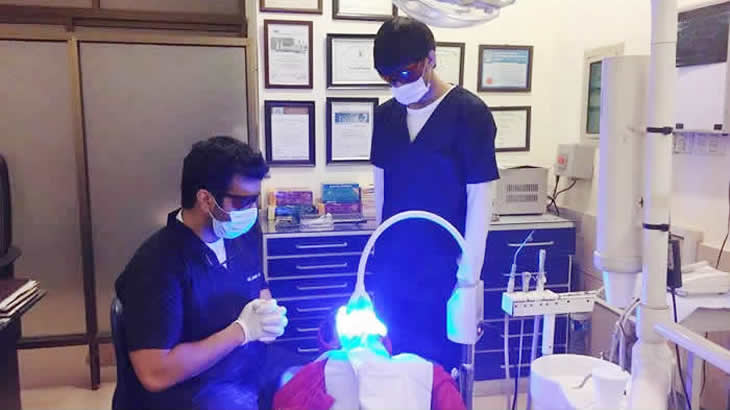
Our best dentist in Allama Iqbal town, Lahore, is one click away to answer your concerns about teeth whitening. Want to know more about our Zoom whitening? Please book an appointment with our best dentist in Lahore for teeth whitening, having a skilled hand in teeth whitening and bleaching procedures.
The cost of teeth whitening in Pakistan ranges from Rs. 15,000 to Rs. 90,000, but at Dental Art, the price is Rs. 45,000, including scaling and polishing. The cost of teeth whitening in Lahore depends on your chosen method; results like in-office whitening can be dramatic.
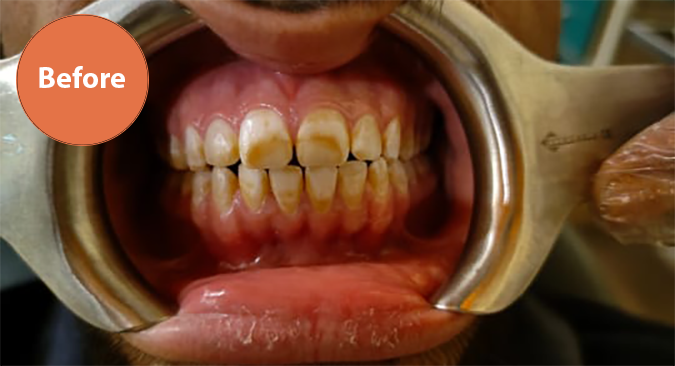
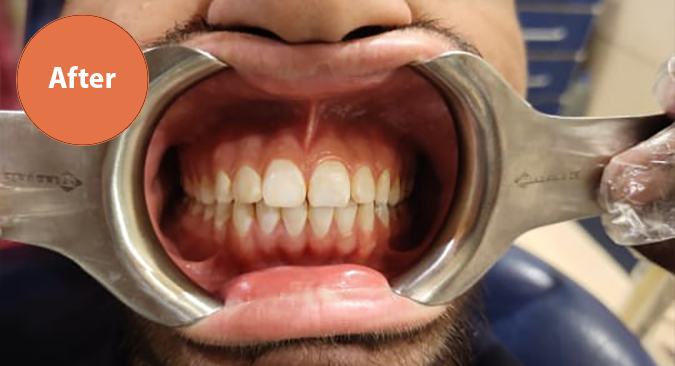
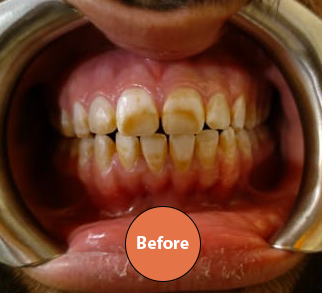
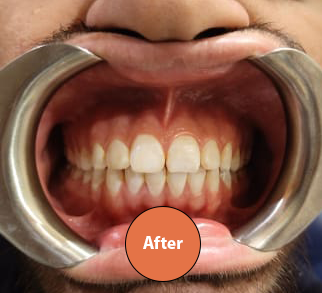
his is another effective way to whiten teeth instantly at home. It uses 15% less hydrogen peroxide, so the patient can handle it easily at home. 'Over-the-counter' teeth whitening treatments are available for use at home. One can whiten teeth at home with over-the-counter strips, gels, pens, toothpaste, rinses, and tooth-whitening trays. OTC medications can be utilized for less severe occurrences of tooth discolouration. When the product's guidelines are followed, less tooth sensitivity is experienced after bleaching at home.
In-chair whitening is quicker and more efficient than at-home bleaching methods. However, some medical professionals build unique bleaching trays, which might take a week to manufacture. Once the whitening therapy is finished, patients can use these trays to maintain their bleaching using at-home kits or de-sensitizing solutions.
Your dentist will give you take-home whitening kits for touch-ups when you feel the shine of your sparkling teeth is fading. Your dentist knows how many kits you need to achieve desirable results.
Want home whitening kits? Shop now or book your order for our Number one top-selling Ultradent home whitening kit!
Depending on the patient's lifestyle, bleaching results might endure for several months. Consuming meals or beverages that stain teeth or have an intense color may reduce the efficacy of the therapy. These include foods and drinks, including coffee, tea, and curries, that contain tannins.
Since some groups may be more susceptible to negative consequences, it is recommended that they proceed cautiously with teeth whitening.
There are no significant side effects of teeth whitening. Still, increased tooth sensitivity, gum sensitivity, and extrinsic tooth discoloration are a few of the adverse effects if you do not follow the proper instructions your dentist gives.
A dentist prescribes and dispenses customized home whitening trays as a patient-administered treatment. Patients must actively participate in their care and carefully adhere to the dentist's instructions. The patient might experience irritation from the bleaching trays, such as blistering or sensitivity of the teeth and surrounding soft tissue. Inconsistent bleaching tray use might cause the whitening process to slow down and err. Some people with strong gag reflexes could not handle the trays and would have to consider alternative teeth-whitening options.
Despite attaining the desired outcomes, stains may reappear after a few months of therapy. To extend the effects of the treatment, a variety of protocols may be used, such as:
Because there is such a wide variety of methods for whitening teeth, the typical teeth bleaching results might last anywhere between six months and three years. However, people often experience effects that last for around a year.
Some patients have reported mild gum discomfort and sensitivity to hot and cold drinks after laser teeth whitening. If you know you have a propensity for experiencing sensitive teeth, inform your dentist and their staff.
The quickest, most noticeable whitening approach is to get an in-office bleaching at a dentist's clinic. Your dentist can remove tough stains in a 45-minute procedure using professional-strength hydrogen peroxide and unique LED/laser light.
Professional teeth whitening almost wholly removes stains from your teeth. Your teeth will return to normal, and more treatments could be required. The majority of individuals get their teeth whitened about every six months.
Teeth-whitening products do not harm teeth. What causes harm is that the person himself is not aware of contraindications in his case, so when the person does self-teeth-whitening with over-the-counter products, he might land himself in trouble with immense pain, burning, and sensitivity. However, using over-the-counter and dentist-administered whitening products can cause transient sensitivity in the teeth and gums.
If you have dental health issues: Before using at-home teeth whitening kits, anyone with periodontal disease, cavities, exposed roots, or damaged enamel should also get advice from a dental practitioner.
The blue LED light may erase stains by penetrating the dental enamel. Note that LED whitening is more effective on yellow teeth than on dark teeth. The quickest method of tooth whitening is Laser whitening. Usually, after the first session with laser teeth whitening, you start to see effects.
The professional teeth whitening technique may help everyone with healthy gums and teeth who want to brighten their smile. It has been demonstrated to be quite successful at removing stains from teeth, including those caused by tetracycline, coffee, tea, cigarettes, and other substances.
On average, teeth may brighten from 6 to 12 shades in the whitening shade range. However, the degree of whitening varies from client to client and cannot be anticipated or guaranteed. The outcome mainly depends on how stained the teeth were to begin with. The most straightforward stains to remove are surface stains, consistently darkened teeth, and yellow or brown teeth. Further whitening procedures could be required to get the ideal shade, particularly with badly discolored teeth.
The procedure results in a whiter, brighter grin in only 30 minutes, divided between two 15-minute administrations, sometimes 45 minutes or 20 minutes each cycle. To ensure optimum gel concentration and light exposure without being exposed to the light for an extended amount of time that can irritate the gums, it is divided into two 15-minute applications. People with sensitive teeth can use a lower power level on the bleaching device to lessen the severity, and people with deep stains could require several treatments.
Fortunately, you can do a few things to keep the results of your tooth whitening. Avoid foods and beverages that might discolor your teeth, such as coffee, tea, soda, berries, and anything with tomato content. Remember to clean your teeth or rinse your mouth if you consume these things. Lastly, ensuring you wash your teeth twice daily and visit the dentist every six months will help stop stains from amassing on your teeth.
Professionally supervised whitening will work faster and better protect sensitive gums and tooth-root surfaces than over-the-counter whitening products. Instead of over-the-counter kits, professional teeth whitening employs a more potent mixture that may give you a dramatically whiter smile in only one session. At-home kits at the pharmacy frequently take a week or more to have apparent benefits.
Plaque- and tartar-free teeth are ideal for teeth whitening. In addition to being crucial for your health, regular dental cleanings will guarantee the finest outcomes for whitening. You may book teeth whitening and dental cleaning for the same day if you need a cleaning. Cleaning should be finished before bleaching.
Caring for Your Whitened Smile
You can do many things to ensure your teeth whitening results last as long as possible, and this will vary from person to person (six months to two years or even longer). First, please maintain your usual, conscientious routine of brushing and flossing daily and keep up with your regular schedule of professional cleanings at the dental office. Rinse teeth with plain water after having foods that stain, including rich curries, processed foods with artificial colors, and beverages like tea and coffee. If you smoke, use your newly whitened teeth as an impetus to quit — a good idea in any event! A minor touch-up every so often, either at home or at the dental office, can keep your smile bright and beautiful for years
When you receive teeth whitening from a dentist, you can be confident that you're getting genuine whitening materials from reliable suppliers administered by workers who have undergone professional training. Additionally, this will lower your risk of experiencing tooth sensitivity or root damage.
Although there is nothing particular you need to do before whitening, it does perform best on teeth that are healthy and free of tartar and plaque. If you know that you have sensitive teeth, preferably visit around two weeks before the whitening to pick up specific toothpaste, or your doctor may prescribe you a prophylaxis painkiller to avoid discomfort during the teeth whitening procedures.
To get the optimum effects, you should refrain from consuming meals or beverages that discolour teeth for at least 48 hours. This includes beverages with artificial hues, such as coffee, tea, juices, and berries. Additionally, you ought to put off smoking as long as you can. Some patients have sensitive teeth, need four-day painkillers, and de-sensitize toothpaste for two weeks.
Many people discover that their teeth get darker and darker over time, frequently turning brown-grey. This is usually the consequence of some form of damage to a tooth. These teeth have historically had extensive drilling and crowns fitted, requiring replacement over a lifetime. However, by using a whitening procedure to whiten scarred teeth in a straightforward internal and external manner, we can provide stunningly natural results without removing or harming any tooth structure.
The best strategy is to have your teeth whitened three weeks before the occasion. If you need a touch-up, opt for three days before. Such a follow-up procedure will only take around 20 minutes, and the brief time is more than worthwhile.
Whitening toothpaste unquestionably assists in cleaning teeth more thoroughly than regular toothpaste. However, many individuals are unaware that dental enamel has layers, much like skin. Only the top layer of the mouth may be cleaned with toothpaste; it cannot go deeper. If the discolouration has been present for a long time, as in smokers, it will have penetrated numerous layers of enamel. No amount of toothpaste will be able to erase it.
No, and yes. Children, teenagers, pregnant and nursing mothers cannot have their teeth professionally whitened for apparent reasons. Your dentist will thoroughly examine your teeth during your initial session to determine whether they are candidates for whitening. The enamel will be thoroughly inspected, and they'll also see if you have sensitive teeth or receding gums. Based on the findings, they will recommend the whitening procedure most suited to your needs, another reason why home whitening kits must be avoided. However, children, teenagers, and nursing mothers can get teeth polishing to restore their teeth shine.
Two types of stains— extrinsic and intrinsic are principally responsible for tooth discoloration and staining.
Extrinsic stains are predominantly spurred by environmental factors, including smoking, pigments in food and drink, and metals like iron or copper; a stain is produced when colored substances from these sources are absorbed into the dental pellicle(outer tooth surface) that have been formed onto the surface of the tooth.
Extrinsic stains can be removed using a variety of therapeutic techniques:
Intrinsic staining occurs predominantly during tooth development, before birth, or early childhood. "intrinsic stains" refers to stains inside the tooth's deep layer that cannot be eliminated mechanically, such as by debridement or prophylactic stain removal. The teeth may seem more yellow with time as a person ages. Examples of intrinsic origins of stains are provided below:
Consumption of tetracycline (broad-spectrum antibiotic) throughout the formative years (2 months to 11 years of age) results in tooth mineralization or calcification, which results in dentin that is yellow-green in hue and visible through the fluorescent enamel under ultraviolet light. Later, when the tetracycline oxidizes, the staining turns darker brown and stops fluorescing when exposed to ultraviolet light.
The most often used active component in whitening products is hydrogen peroxide, and the other is carbamide peroxide. Hydrogen peroxide acts as an oxidizing agent when it diffuses into the tooth, where it breaks down to create unstable free radicals. These uncontrollable free radicals attach to organic pigment molecules in the spaces between the inorganic salts in tooth enamel, forming tiny, less pigmented components. Due to their decreased size and less light reflection, these molecules provide a "whitening effect."
The way that tooth color is perceived is intricate. Many factors can affect a tooth's ability to reflect and absorb light, including the observer, eye fatigue, light source, specular transmission through the tooth, specular reflection at the surface, diffuse light reflection at the surface, absorption, and scattering of light within the dental tissues, enamel mineral content, enamel thickness, dentine color, and the amount of light that strikes the tooth.
The couplings of intrinsic and extrinsic stains on dental surfaces affect tooth color and, consequently, tooth appearance. The inherent color of teeth is determined by light scattering and absorption within the enamel and dentine. Because the enamel is relatively translucent, the dentinal characteristics can dramatically affect the overall color of teeth. On the other hand, extrinsic stain and color are caused by colored areas that have developed inside the plaque on the enamel surface and can be altered by everyday habits. For instance, eating meals high in tannins, brushing your teeth poorly, using tobacco products, and being predisposed to iron salts and chlorhexidine can all darken the color of your teeth.
There are additional ways to conceal the stain if a patient's teeth have significant staining or tetracycline damage and whitening is ineffective (tetracycline staining may require prolonged bleaching since it takes longer for the bleach to reach the dentine layer). During bonding, a thin layer of composite material is put on the front of a person's teeth, covering up dental stains. The composite material is then cured using a blue light. A veneer can also conceal stained teeth.
To lessen the possibility of chemical burns to the soft tissues during in-office bleaching operations, a light-cured protective coating is often carefully sprayed on the gums and papilla (the tips of the gums between the teeth). Either hydrogen peroxide or carbamide peroxide, which is broken down into hydrogen peroxide in the mouth, is used as a bleaching agent, and results can be seen within an hour.
Teeth whitening is a perfect solution for smoking, coffee, tea, fluorosis, and tetracycline stains. Modern cosmetic dentistry can instantly transform your appearance in just a few minutes. Having an intra-oral examination before you begin teeth whitening is an essential first step to ensure your tooth discoloration is not the result of a dental condition in need of treatment.